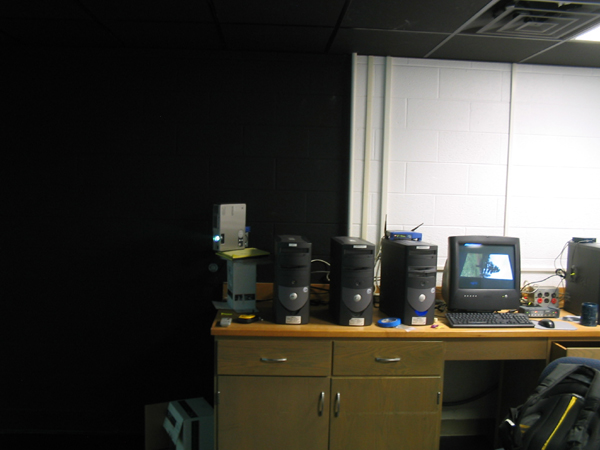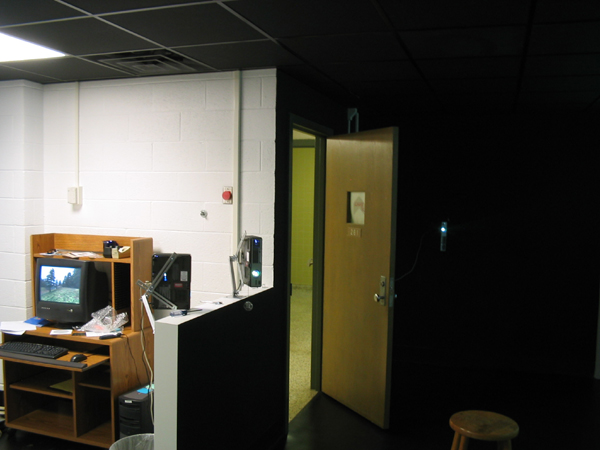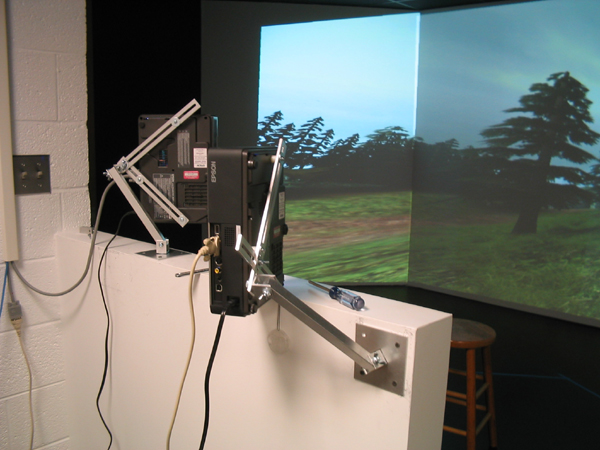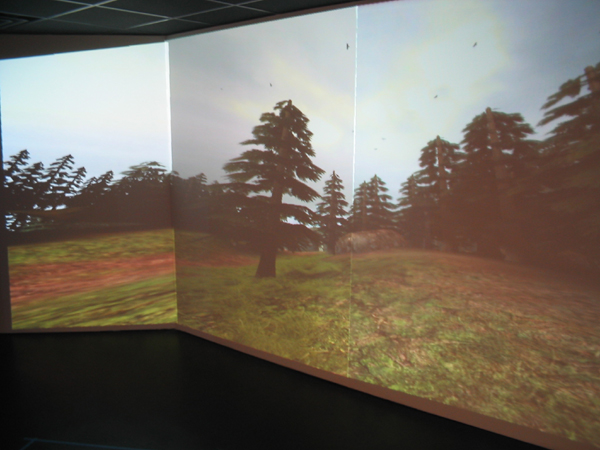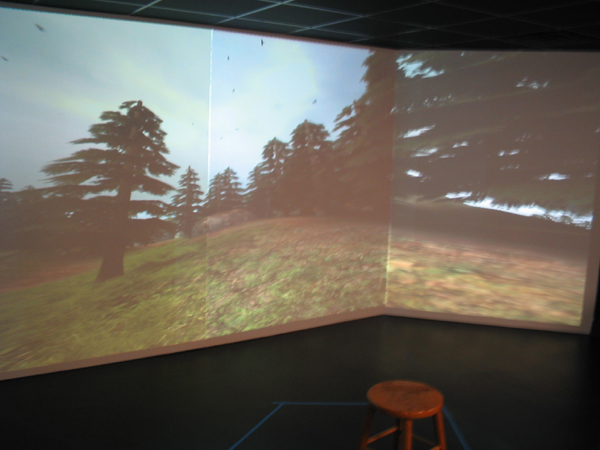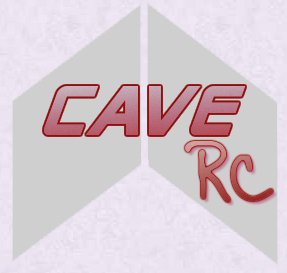 |
Adding Depth to our Understanding
|
Despite the fact that mankind has been encoding ideas into graphical
icons since before persistently recorded history,
it was less than 20 years ago that the National Science Foundation
launched an initiative to study the impact of the discipline of visualization
This is not to criticize the timeliness of government agencies but rather to
underscore the technological developments that demand formal study of visualization.
Until recently, the process of a graphic designer was laborious and the creation was often static.
The viewer was therefore limited to the role of a passive observer to a pre-formulated, explicit message. Advances in computer graphics mean that more
complex displays can be produced and manipulated with minimal effort,
opening the door to highly interactive representations of visual data.
One branch of interactive visualization that has emerged deals 3D
modeling of inherently spatial data. Advocates
of this new technology claim that natural experiences with the
real (3D) world will transfer into synthetic (3D) visualization
displays and vice versa. This is the basis
for simulation-based training and virtual reality experiences.
To measure the effectiveness of a 3D experience, researchers
often attempt to measure Presence, the subjective experience of being in one
place or environment, even when one is physically situated in another. Although it
is difficult to
quantify presence, it is often understood that a narrow field of view (FOV) for the display is frequently one of the main inhibitors, interfering
with the
ability to integrate information from the environment. Since standard a
standard desktop display occupies approximately 20% of the total human
field of view, there is a lot of peripheral noise that can distract the viewer.
One way to expand the FOV is to use large, multiscreen displays that
are generally classified as CAVES. These special displays
span a wide range of a person’s field of view, allowing him/her
to be more completely engaged in visual experience.
CaveRC achieves this effect using common office
equipment according to the design outlined by Jacobson and Lewis
(pdf).
The basic construction of CaveRC
provides a valuable platform from which to study the effectiveness of
large, multi-screen 3D displays. This research plans to
follow two parallel tracks.
Evaluation of the display from
a technology
perspective
CaveRC is constructed from ordinary office supplies, and is touted as a low-cost
alternative to high-end, custom-built displays. Clearly there are technological trade-offs
being made. More advanced technologies can always be added, but are they worth the value?
We are particularly interested in assessing the value of several enhancements:
- Input Devices & Control Metaphors:
Input devices provide the mechanisms by which the viewer communicates intentions to the display.
To fully interact with a 3D display, an input device must be capable of manipulating six degrees-of-freedom. Unfortunately, the mainstream controllers, mice and
joysticks, are only capable of manipulating two degrees of freedom. Several specialized
devices have come on the market to overcome this problem, but there are anecdotal reports that
these devices are too complex for the average user. The physical interaction required to position the viewpoint at meaningful locations can directly compete with cognitive task of
extracting relevant information from the display. Human
performance evaluations need to be conducted to assess the interaction
effectiveness of various input devices, and control metaphors.
- Stereopsis: One of the cues that humans rely on to
perceive 3D is known as binocular disparity; each eye receives a
slightly different view of the world. This can be simulated by simultaneously
presenting both images and selectively filtering the images with polarized glasses,
giving a richer 3D experience. At a minimum, this doubles the cost of the
projection system. Under what conditions is there an equivalent perceptual benefit to the viewer?
- Number of Screens: Additional screens
can be added to CaveRC for roughly the cost of a projector unit and
another PC. In the initial implementation used 2 screens projected into the corner of a room.
Can the experience be made much richer with
a 3-wall environment? What is the benefit to projecting to the
floor or ceiling?
Systematically evaluating the benefits of these and other components can inform the
design of future systems. When deciding to construct a new display system, developers can
justify, or at least understand the ramifications of including or excluding various components.
Evaluation of the display from an application perspective
More complex than the hardware assembly is developing meaningful environments to explore.
Fortunately, there are several useful “Worlds” that are associated with
CAVEUT, a freeware
package that will be used to power the CaveRC. Additional efforts are
underway to integrate Chromium
technology with CaveRC, which would allow any OpenGL based program to
be displayed. Many visualizations are already in use on a desktop
setting, but for some applications, viewers may benefit from an
immersive experience. This objective seeks to determine if there are particular
characteristics of applications that lend themselves to 3D immersive visualization.
To this end, it is fortunate to be conducting this research in a liberal arts setting because of the
cross-disciplinary nature. Some of the applications that we hope to explore include:
- History: Visualization is frequently used to reconstruct historical sites.
The CaveUT package comes with a reconstruction of an Egyptian temple and sections of Pompeii.
Other environments will be constructed according to the specific
interests of our faculty. Unlike video recreations and reenactments, the viewers are free
to explore according to their interests – which may cause problems if the model is not
completely accurate. This active field of research is also known as virtual heritage, and is dedicated to exploring questions dealing with this new media.
- Human Performance: One of the early applications of CAVEs was to better understand balance disorders. Visual feedback could be used to induce disorientation to help researchers understand some of the physiological responses. Additionally, “simulator sickness” is a common problem that occurs in CAVE displays. Further work could be done to understand
how to mitigate it.
- Chemistry: - CaveRC could prove useful for the visualization of molecular structures.
The makeup and topology of chemical structures are sufficiently complex and physically
inaccessible to make visualization a powerful tool for understanding molecular interactions. Is it beneficial to "Walk through" a molecule" or is it better to treat it as a object that you can hold in your hand?
- Psychology: CaveRC could be used to conduct more foundational research into human perception and cognition. Of particular relevance might be studies to understand spatial
cognition and how people become aware of their surroundings. This line of research could be particularly valuable in the training of emergency first responers - which coupled
with the relatively low-cost of establishing CaveRC could prove
invaluable.


